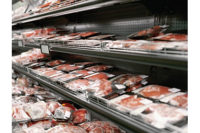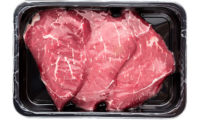Like it or not, time and experience usually uncover where we fit in the scheme of things. We may not like to admit it, but sooner or later each of us discovers where we deliver the greatest value, professionally, and where we do not.
Oddly enough, it is not that different with food packaging.
Two seasoned and proven technologies, modified atmosphere packaging (MAP) and overwrap, look to have settled into their unique niches.
In the last eight years, MAP’s share of retail meat case packaging has plateaued at 12 percent while PVC overwrap declined to 34 percent from 42 percent in 2010, according to data from the 2018 Sealed Air National Meat Case Study. “MAP has sort of found its place in ground products, and a lot of that is in ground beef and ground turkey. It’s an accepted package by shoppers for those products,” observed a veteran industry executive.
For more than two decades, MAP has been a prominent face of case-ready packaging. It has proven itself as an effective package, checking several essential performance boxes for retailers and shoppers alike. Some of those boxes include the fact they have a hermetic seal, and are leak proof and durable. But is there a looming threat to upset this steadiness? Consumers today are generally more and more attuned to the amount of packaging associated with all products. Too much packaging can be interpreted as an unnecessary expense or just plain wasteful. Less packaging, or at least the perception of less, counts a lot more now than even a decade ago. Depending on how much headspace there is compared with the volume of the product it protects, MAP may look to some in our more environmentally plugged-in marketplace as too much packaging. There is no cause for panic here, but careful observation of these attitudes cannot hurt.
Despite its packaging share in America’s meat cases steadily eroding over the past two decades, PVC overwrap leveled off at 33 percent and 34 percent, respectively, in 2015 and 2018, based on National Meat Case Study findings. Consequently, PVC overwrap may also have found its balance. For retailers it represents an easy transition to case ready by going into a PVC master pouch program. Shoppers do not notice any difference because they see the same kind and color of tray. “For those transitioning to case ready, it is the easiest way to sell management and shoppers,” the executive says; however, balance can be a precarious circumstance.
Data shows that overwrap has been yielding packaging share to vacuum formats for beef applications for several years. The emergence of an expanded menu of premium products such as natural, grass-fed, antibiotic-free, to name a few, and a marketplace more receptive to their message has outstripped PVC overwrap’s performance capabilities. These more expensive options do not turn as fast as value cuts, compelling retailers to turn to vacuum packaging for extended product shelf life. It enables them to reduce shrink while providing shoppers a full product selection.
Overwrap may also be affected indirectly by public policy. Single-use polystyrene foam, which includes trays, has been under increasing pressure for some time in many municipalities and states throughout the U.S. If foam trays are removed from the supply chain, their likely replacements will be more expensive rigid plastic trays. How overwrap fits into that picture is anyone’s guess.
MAP and overwrap may have found their places, but nothing is forever. Changing marketplace dynamics and shifting social norms leave them no room for complacency. NP






Report Abusive Comment